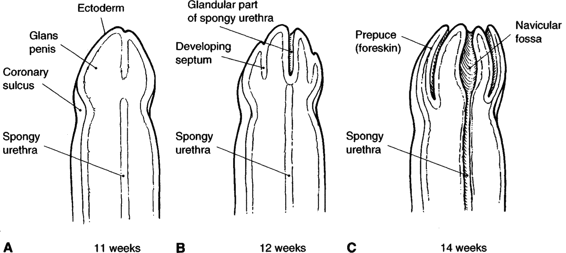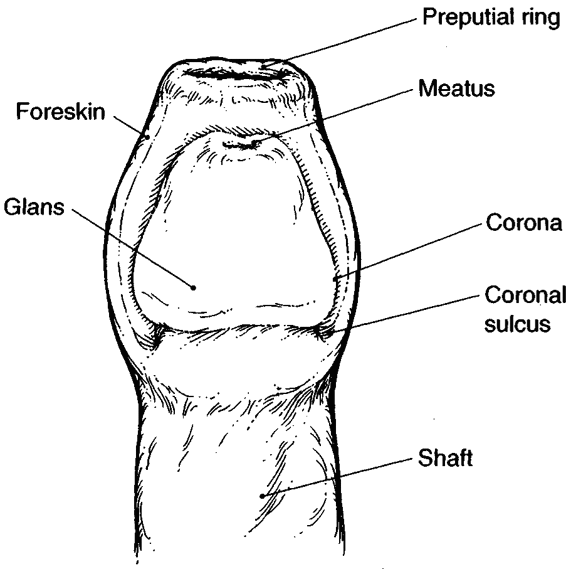Circumcision
Newborn male circumcisions have been performed for centuries and are described in the book of Genesis (17:10-14, 34:14-16). The exact frequency of circumcision is unknown, but in the United States, it is estimated that 1.2 million newborn males undergo circumcision each year (American Academy of Pediatrics, 1999). Worldwide, it is estimated that circumcision is performed on 1 of 6 males (Holman and colleagues, 1995). Few surgical procedures generate as much controversy as the removal of this small free fold of skin. Circumcisions are performed for a variety of reasons including parental preference, religious requirements, and for preventive health measures.
The American Academy of Pediatrics (AAP) has published several policy statements on neonatal circumcision. In its 1971 manual, Standards and Recommendations of Hospital Care of Newborn Infants, which was reiterated in the 1975 and 1985 revisions, the AAP concluded that there was no absolute medical indication for routine circumcision (American Academy of Pediatrics, 1999). In 1989, the AAP concluded that newborn male circumcision had potential medical benefits and advantages as well as disadvantages and risks. These new recommendations stemmed from research exploring links between circumcision status and both urinary tract infections (UTIs) and sexually transmitted disease (STD)/human immunodeficiency virus (HIV) (American Academy of Pediatrics, 1999). In 1990, the American Academy of Family Physicians issued its position statement on circumcision: “current medical literature regarding neonatal circumcision is controversial and conflicting” (Holman and colleagues, 1995). Other medical societies worldwide have published statements that do not recommend routine neonatal circumcision (American Academy of Pediatrics, 1999). Due to the debate concerning the necessity of neonatal circumcision of male infants and analysis of almost 40 years of medical research on circumcision, the AAP issued new recommendations on March 1, 1999. The AAP now states, “existing scientific evidence demonstrates potential medical benefits of newborn male circumcision; however, these data are not sufficient to recommend routine neonatal circumcision.” Parents are encouraged to discuss the risks and benefits of neonatal circumcision with their physician and to then make an informed decision (American Academy of Pediatrics, 1999).
HISTORY
Circumcision is one of the oldest and most widely performed operations known to man. For certain groups, circumcision is a religious requirement. Circumcision is accomplished on male Jewish infants on the eighth day after birth in a ceremony called a bris. In orthodox Judaism, an official known as a mohel performs the circumcision, while some reform Jews allow the procedure to be accomplished by a physician (Allan, 1989). In an excellent review, Grossman and Posner (1981) detail the development of surgical techniques used for circumcision. The Bible describes the use of flint knives as instruments. The codes of Maimonides describes the basic steps of excision of the prepuce, tearing of the mucosa with a thumbnail, and exposure of the glans (Maimonides, 1947). Early surgical improvement involved preventing trauma. Sharp knives negated the need for tearing the skin. In the 1700s, a metal plate was used that prevented damage to the glans (Karo and Shulchan, 1960). In the early 1900s, a Moslem physician protected the glans by tying two sutures around the stretched prepuce and cut between the two knots (Bryk, 1934). Topical antibiotics and various surgical clamps led to a reduction in bleeding and infection. Hence, by the 1930s, complications of the procedure were minimal.
Urologic research in the 1930s revealed that circumcision prevented cancer of the penis. Wolbarst, in a review of more than 1100 cases of penile cancer, found none in men who were circumcised as newborns (Wolbarst, 1932). Schoen (1990) analyzed penile cancer and noted that there had been 750–1000 cases annually in the United States, yet only three cases of penile cancer had been reported in the last 20 years in men circumcised as newborns. During World War II, both United States and Canadian studies suggested that circumcision promoted genital hygiene, prevented balanitis, balanoposthitis, phimosis, and paraphimosis, and decreased the incidence of sexually transmitted disease (Wilson, 1947; Gellis, 1978). Thus, in the 1940s, physicians prescribed newborn circumcision as a simple, minor procedure that promoted hygiene and prevented genital disease.
The American Academy of Family Physicians’ position statement on circumcision reminds us that “proponents cite potential benefits in regard to penile cancer, cervical cancer in the male’s partner, sexually transmitted diseases including HIV infection, and neonatal urinary tract infections and their sequelae. Conversely, other physicians are not convinced of these relationships and argue that optimal hygiene affords as much protection as circumcision does” (Holman and colleagues, 1995). Moses and colleagues (1998) reviewed the current knowledge of the health benefits and risks associated with male circumcision. They found substantial evidence that circumcision protects males from HIV infection, penile carcinoma, urinary tract infections, and ulcerative sexually transmitted diseases and found little adverse effects on sexual, psychological, or emotional health. They concluded that the decision to recommend male circumcision in a given society should be based on a risk-benefit ratio: the risk for and the occurrence of the diseases that are associated with the foreskin, versus the risk of the complications of the procedure.
The 1999 AAP policy recommendations are based on a review of all available English language medical literature published between 1960 and 1999. The risk of developing a UTI in the first year of life is higher in uncircumcised boys, but their absolute risk is low, at most 1 percent. An uncircumcised male infant has about a 1 in 100 chance of developing a UTI, whereas if circumcised, the risk is about 1 in 1000. Uncircumcised males have more than a three-fold risk of developing penile cancer; however, in the United States, the incidence is rare, only 9–10 cases are diagnosed per year per 1 million men. Therefore, the overall risk of developing penile cancer in the uncircumcised male is extremely low. The AAP reviewed the evidence regarding the relationship of circumcision to STDs. The literature suggests that circumcised males may be at less risk for syphilis and uncircumcised males at increased risk for HIV infection. However, behavioral factors are likely more important in the acquisition of STD/HIV rather than whether circumcised. For decades improved penile hygiene has been a reason given for neonatal circumcision, but there is little evidence to support this view. Care and genital hygiene of the uncircumcised penis should be emphasized as a preventative health topic throughout a patient’s life.
ANATOMY AND EMBRYOLOGY
To master any surgical technique, the operator should understand the pertinent anatomy and embryology. Circumcision is no exception to this dictum. The epithelium of the spongy urethra, except the glandular portion, emanates from the cells of the urogenital sinus (Fig. 37-1A). The epithelium of the navicular fossa (Figs. 37-1B and C) develops by canalization of ectodermal cells known as the glandular plate, which extends from the tip of the penis. Splanchnic mesenchyme is the source of the connective tissue and smooth muscle of the penis. The prepuce develops as a circular ingrowth of ectoderm at the periphery of the glans penis during the twelfth week of development (Fig. 37-1B; Moore, 1982). This in-growth forms a septum, which then breaks down except for the area vertical to the glans that forms the frenulum. Subsequently, a double-layer or free-fold of skin exists as the prepuce.
FIGURE 37-1. Development of the penis with prepuce and glandular portion of spongy urethra at 11 (A), 12 (B), and 14 (C) weeks gestation. (Adapted from Moore, 1982, with permission.)
Figure 37-2 shows the normal anatomy of the foreskin (or prepuce). The prepuce, also known as the foreskin, is the free-fold of the skin that covers the glans penis. The preputial space denotes the area between the glans penis and the prepuce. The corona refers to the base of the glans penis, and the coronal sulcus lies between the glans and the penile shaft. In newborn males, the foreskin fully retracts in 4 percent, the glans recedes revealing the urethral meatus in 54 percent, and the tip of the glans cannot be seen in 42 percent (Anderson, 1989). The foreskin may not be fully retractable until several years after birth; in 90 percent of uncircumcised males, the foreskin is retractable by age 5 years (American Academy of Pediatrics, 1999). By puberty, daily hygiene includes cleansing of the preputial space.
FIGURE 37-2. The normal anatomy of the penis and foreskin.
Circumcision is defined as the surgical excision of the foreskin to the level of the coronal sulcus. Circumcision may be performed in the newborn period or later in life as a treatment for several conditions. Phimosis is a stenosis of the preputial ring, which prevents retraction of the foreskin. Paraphimosis consists of a partial stenosis with retraction usually blocked at the level of the corona. Balanitis and posthitis signify inflammation or infection of the glans and prepuce, respectively. Phimosis, paraphimosis, and recurrent balanoposthitis are indications for circumcision. Five to 10 percent of uncircumcised males require circumcision for these conditions (McKim, 1947; Warner and Streskin, 1981).
SURGICAL TECHNIQUE: METHODS OF CIRCUMCISION
Circumcision is a safe surgical procedure if performed by a trained operator using sterile technique. Trained operators include obstetricians, pediatricians, family practitioners, urologists, and members of the religious community. Newborn circumcision should be performed only on a healthy, stable infant. Contraindications of circumcision are listed in Table 37-1. We do not recommend routine neonatal circumcision on infants weighing less than 2500 g. It should also not be performed on infants with evidence of a coagulopathy or with penile or scrotal anomalies. Furthermore, if a family history of a coagulopathy exists, it should be ruled out in the infant prior to the procedure. Penile and scrotal anomalies include a short phallus; small phallus; any degree of hypospadias; a hooded prepuce; a dorsal cutaneous hump; penile curvature; penile torsion; penoscrotal fusion; or a large hydrocele or inguinal hernia extending into the scrotum (Redman and Elser, 1997).
TABLE 37-1. Contraindications and Relative Contraindications to Routine Newborn Circumcision
Bleeding abnormality
Family history of bleeding disorder not ruled out in infant
Infection
Unstable infant
Hypospadias and outer genitourinary anomalies
Abnormal body temperature
Abnormal feeding
The most commonly used instruments for neonatal circumcision include the Gomco and Mogen clamps, and the Plastibell device (Fig. 37-3). In a review of nearly 6000 patients, complications with the Gomco clamp and Plastibell were rare and minor (Gee and Ansell, 1976; Table 37-2
Stay updated, free articles. Join our Telegram channel

Full access? Get Clinical Tree




